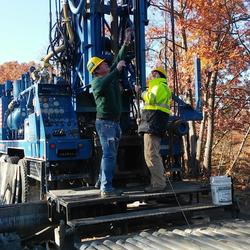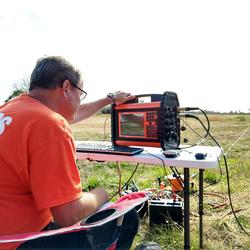John Peter Masterson
John Masterson is the Associate Director for Science Operations in the New York Water Science Center. He completed his B.A. in Geosciences at SUNY Geneseo and M.S. in Geosciences at the University of Missouri-Columbia.
John began his USGS career at the New York Water Science Center on Long Island in 1987, transferred to the New England Water Science Center in Massachusetts in 1990, and has returned to the New York Water Science Center in 2021. He specializes in computer model applications to study groundwater flow dynamics and is an author of numerous USGS technical reports and peer-reviewed articles on groundwater resources in coastal aquifer systems. John is currently serving as the project coordinator for the ongoing NYSDEC-USGS cooperative investigation of groundwater sustainability of the Long Island regional aquifer system.
Professional Experience
USGS the New York Water Science Center as Associate Director for Science Operations in 2021-present
New England Water Science Center in Massachusetts in 1990-2021
USGS the New York Water Science Center on Long Island in 1987-1990
Education and Certifications
M.S. in Geosciences at the University of Missouri-Columbia.
B.A. in Geosciences at SUNY Geneseo
Science and Products
Groundwater Sustainability of the Long Island Aquifer System
Hydrogeologic-Framework Mapping - Long Island, New York
Saltwater-Interface Mapping - Long Island, New York
Groundwater Flow Modeling - Long Island, New York
Groundwater Availability of the Northern Atlantic Coastal Plain
MODFLOW 6 Model Used to Simulate Groundwater Flow in the Long Island, New York Regional Aquifer System for 1900–2019 Pumping and Recharge Conditions
Soil-water-balance groundwater recharge model results for Long Island, NY, 1900-2019
Simulated Groundwater Contributing Areas to Selected Streams, Ponds, Coastal Water Bodies, and Production Wells, Plymouth-Carver Region and Cape Cod, Massachusetts
Statistical summaries of simulated groundwater residence times for the 10 regional aquifers of the Northern Atlantic Coastal Plain aquifer system, at a 1 square-mile grid resolution
Simulation of groundwater flow in the Long Island, New York regional aquifer system for pumping and recharge conditions from 1900 to 2019
Preparing for today's and tomorrow's water-resources challenges in eastern Long Island, New York
A century of hydrologic data collection prepares western Long Island for current and future water-resources challenges
Application of a soil-water-balance model to estimate annual groundwater recharge for Long Island, New York, 1900–2019
Managing water resources on Long Island, New York, with integrated, multidisciplinary science
Simulated effects of sea-level rise on the shallow, fresh groundwater system of Assateague Island, Maryland and Virginia
Simulation of groundwater flow in the regional aquifer system on Long Island, New York, for pumping and recharge conditions in 2005–15
Water for Long Island: Now and for the future
Do you ever wonder where your water comes from? If you live in Nassau or Suffolk County, the answer is, groundwater. Groundwater is water that started out as precipitation (rain and snow melt) and seeped into the ground. This seepage recharges the freshwater stored underground, in the spaces between the grains of sand and gravel in what are referred to as aquifers. Long Island has three primary aq
Development of simulated groundwater-contributing areas to selected streams, ponds, coastal water bodies, and production wells in the Plymouth-Carver region and Cape Cod, Massachusetts
Documentation of a groundwater flow model developed to assess groundwater availability in the Northern Atlantic Coastal Plain aquifer system from Long Island, New York, to North Carolina
Assessment of groundwater availability in the Northern Atlantic Coastal Plain aquifer system From Long Island, New York, to North Carolina
Sustainability of groundwater supplies in the Northern Atlantic Coastal Plain aquifer system
Non-USGS Publications**
May 1 – 5, 2011
to Coastal Embayments, Western Cape Cod, Massachusetts: in Proceedings of the Geological Society of America National Meeting, Boston, Massachusetts,
November 1-10, 2001.
public-supply wells, streams, ponds, and coastal embayments, western Cape Cod, Massachusetts: in Proceedings of the National Ground Water Association Northeast Focus Ground Water Conference, Burlington, Vermont, October 20-21, 1998.
computerized visualization of fluid-particle pathlines for simulated contaminant plumes in ground-water, Massachusetts Military Reservation, Cape Cod, Massachusetts: in Proceedings of the Geological Society of America Annual Meeting, Seattle, Washington, October 24-27, 1994, v. 26, No. 7.
withdrawals and recharge on the hydrology of the sole-source Cape Cod Aquifer,
Massachusetts: in Proceedings of the National Ground Water Association Focus
Conference on Eastern Ground Water Issues, Burlington, Vermont, October 3-5,
1994.
**Disclaimer: The views expressed in Non-USGS publications are those of the author and do not represent the views of the USGS, Department of the Interior, or the U.S. Government.
Science and Products
Groundwater Sustainability of the Long Island Aquifer System
Hydrogeologic-Framework Mapping - Long Island, New York
Saltwater-Interface Mapping - Long Island, New York
Groundwater Flow Modeling - Long Island, New York
Groundwater Availability of the Northern Atlantic Coastal Plain
MODFLOW 6 Model Used to Simulate Groundwater Flow in the Long Island, New York Regional Aquifer System for 1900–2019 Pumping and Recharge Conditions
Soil-water-balance groundwater recharge model results for Long Island, NY, 1900-2019
Simulated Groundwater Contributing Areas to Selected Streams, Ponds, Coastal Water Bodies, and Production Wells, Plymouth-Carver Region and Cape Cod, Massachusetts
Statistical summaries of simulated groundwater residence times for the 10 regional aquifers of the Northern Atlantic Coastal Plain aquifer system, at a 1 square-mile grid resolution
Simulation of groundwater flow in the Long Island, New York regional aquifer system for pumping and recharge conditions from 1900 to 2019
Preparing for today's and tomorrow's water-resources challenges in eastern Long Island, New York
A century of hydrologic data collection prepares western Long Island for current and future water-resources challenges
Application of a soil-water-balance model to estimate annual groundwater recharge for Long Island, New York, 1900–2019
Managing water resources on Long Island, New York, with integrated, multidisciplinary science
Simulated effects of sea-level rise on the shallow, fresh groundwater system of Assateague Island, Maryland and Virginia
Simulation of groundwater flow in the regional aquifer system on Long Island, New York, for pumping and recharge conditions in 2005–15
Water for Long Island: Now and for the future
Do you ever wonder where your water comes from? If you live in Nassau or Suffolk County, the answer is, groundwater. Groundwater is water that started out as precipitation (rain and snow melt) and seeped into the ground. This seepage recharges the freshwater stored underground, in the spaces between the grains of sand and gravel in what are referred to as aquifers. Long Island has three primary aq
Development of simulated groundwater-contributing areas to selected streams, ponds, coastal water bodies, and production wells in the Plymouth-Carver region and Cape Cod, Massachusetts
Documentation of a groundwater flow model developed to assess groundwater availability in the Northern Atlantic Coastal Plain aquifer system from Long Island, New York, to North Carolina
Assessment of groundwater availability in the Northern Atlantic Coastal Plain aquifer system From Long Island, New York, to North Carolina
Sustainability of groundwater supplies in the Northern Atlantic Coastal Plain aquifer system
Non-USGS Publications**
May 1 – 5, 2011
to Coastal Embayments, Western Cape Cod, Massachusetts: in Proceedings of the Geological Society of America National Meeting, Boston, Massachusetts,
November 1-10, 2001.
public-supply wells, streams, ponds, and coastal embayments, western Cape Cod, Massachusetts: in Proceedings of the National Ground Water Association Northeast Focus Ground Water Conference, Burlington, Vermont, October 20-21, 1998.
computerized visualization of fluid-particle pathlines for simulated contaminant plumes in ground-water, Massachusetts Military Reservation, Cape Cod, Massachusetts: in Proceedings of the Geological Society of America Annual Meeting, Seattle, Washington, October 24-27, 1994, v. 26, No. 7.
withdrawals and recharge on the hydrology of the sole-source Cape Cod Aquifer,
Massachusetts: in Proceedings of the National Ground Water Association Focus
Conference on Eastern Ground Water Issues, Burlington, Vermont, October 3-5,
1994.
**Disclaimer: The views expressed in Non-USGS publications are those of the author and do not represent the views of the USGS, Department of the Interior, or the U.S. Government.





